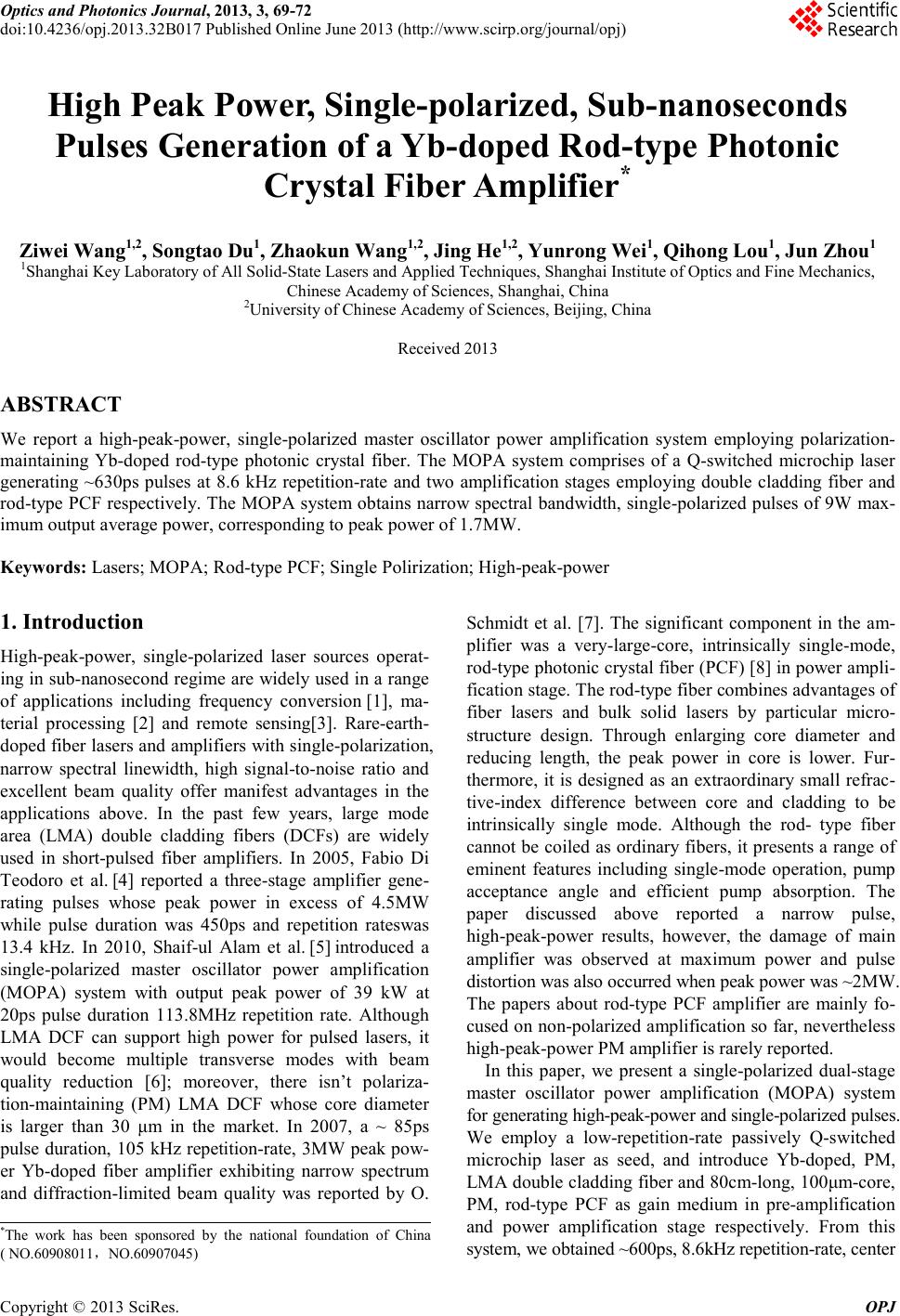
Optics and Photonics Journal, 2013, 3, 69-72
doi:10.4236/opj.2013.32B017 Published Online June 2013 (http://www.scirp.org/journal/opj)
Copyright © 2013 S ciRes. OPJ
High Peak Power, Single-polarized, Sub-nanoseconds
Pulses Generation of a Yb-doped Rod-type Photonic
Crystal Fiber Amplifier*
Ziwei Wang1,2, Songtao Du1, Zhaokun Wang1,2, Jing He1,2, Yunrong Wei1, Qihong Lou1, Jun Zhou1
1Shanghai Key Laboratory of All Solid-St ate Lasers and Applied Techniques, Shang ha i Insti tute of Optic s and Fi ne Me c ha ni c s ,
Chinese Academy of Scien ces , Shanghai, China
2Universi ty of Chinese Academy of Scien ces , Beijing, China
Received 2013
ABSTRACT
We report a high-peak-power, single-polarized master oscillator power amplification system employing polarization-
maintaining Yb-doped rod-type photonic crystal fiber. The MOPA system comprises of a Q-switched microchip laser
generating ~630ps pulses at 8.6 kHz repetition-rate and two amplification stages employing double cladding fiber and
rod-type PCF respectively. The MOPA system obtains narrow spectral bandwidth, single-polarized pulses of 9W max-
imum output average power, corresponding to peak power of 1.7MW.
Keywords: Lasers; MOPA; Rod-type PCF; Single Poliriza tion; High-peak-power
1. Introduction
High-peak-power, single-polarized laser sources operat-
ing in sub-nanosecond regime are widely used in a range
of applications including frequency conversion [1], ma-
terial processing [2] and remote sensing[3]. Rare-earth-
doped fiber lasers and amplifiers with single-polarization,
narrow spectral linewidth, high signal-to-noise ratio and
excellent beam quality offer manifest advantages in the
applications above. In the past few years, large mode
area (LMA) double cladding fibers (DCFs) are widely
used in short-pulsed fiber amplifiers. In 2005, Fabio Di
Teodoro et al. [4] reported a three-stage amplifier gene-
rating pulses whose peak power in excess of 4.5MW
while pulse duration was 450ps and repetition rateswas
13.4 kHz. In 2010, Shaif-ul Alam et al. [5] introduced a
single-polarized master oscillator power amplification
(MOPA) system with output peak power of 39 kW at
20ps pulse duration 113.8MHz repetition rate. Although
LMA DCF can support high power for pulsed lasers, it
would become multiple transverse modes with beam
quality reduction [6]; moreover, there isn’t polariza-
tion-maintaining (PM) LMA DCF whose core diameter
is larger than 30 μm in the market. In 2007, a ~ 85ps
pulse duration, 105 kHz repetition-rate, 3MW peak pow-
er Yb-doped fiber amplifier exhibiting narrow spectrum
and diffraction-limited beam quality was reported by O.
Schmidt et al. [7]. T he significant component in the am-
plifier was a very-large-core, intrinsically single-mode,
rod-type photonic crystal fiber (PCF) [8] in power ampli-
fication stage. The rod-type fiber combines advantages of
fiber lasers and bulk solid lasers by particular micro-
structure design. Through enlarging core diameter and
reducing length, the peak power in core is lower. Fur-
thermore, it is designed as an extraordinary small refrac-
tive-index difference between core and cladding to be
intrinsically single mode. Although the rod- type fiber
cannot be coiled as ordinary fibers, it presents a range of
eminent features including single-mode operation, pump
acceptance angle and efficient pump absorption. The
paper discussed above reported a narrow pulse,
high-peak-power results, however, the damage of main
amplifier was observed at maximum power and pulse
distortion was also occurred when peak power was ~2MW.
The papers about rod-type PCF amplifier are mainly fo-
cused on non-polarize d amplificatio n so far, neverthe less
high-peak-power PM amplifier is rarely reported.
In this paper, we present a single-polarized dual-stage
master oscillator power amplification (MOPA) system
for ge nera ting hi gh-peak-po wer and si ngle -polarized pulses.
We employ a low-repetition-rate passively Q-switched
microchip laser as seed, and introduce Yb-doped, PM,
LMA double cladding fiber and 80cm-long, 100μm-core,
PM, rod-type PCF as gain medium in pre-amplification
and power amplification stage respectively. From this
system, we obtained ~600ps, 8.6kHz repetition-rate, center
*The work has been sponsored by the national foundation of
( NO.60908011,NO.60907045)